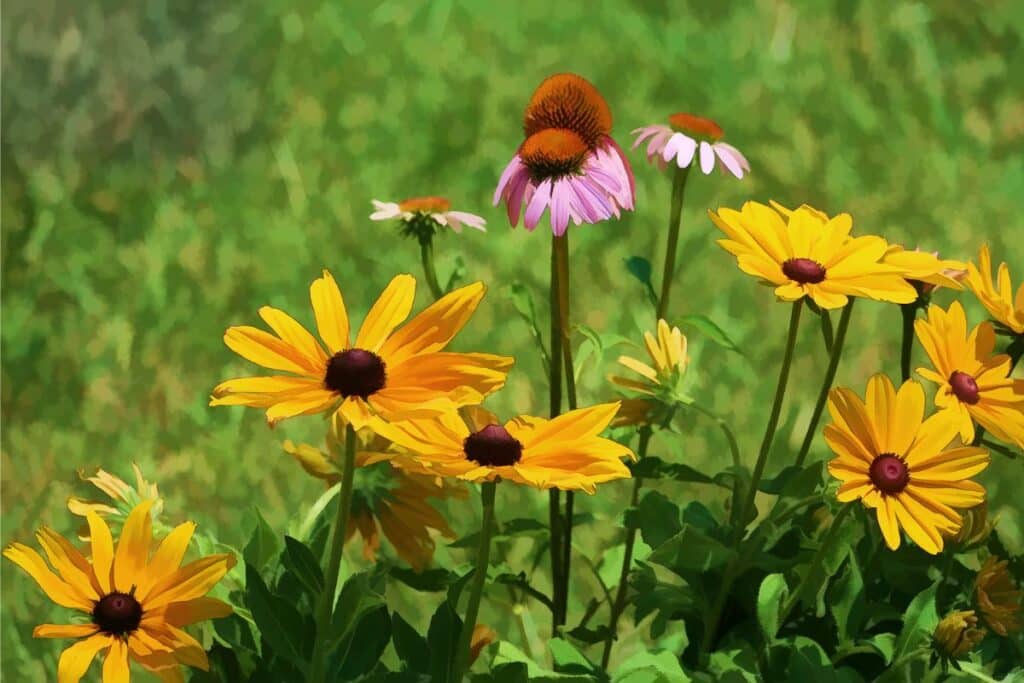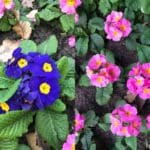Black-eyed Susans (Rudbeckia hirta), also referred to as Gloriosa daisies, certainly are some of the more interesting flower species that you can add to an ornamental garden. These plants look like tiny sunflowers with their bright yellow petals and dark centers.
In truth, they are members of the sunflower family and are ideal plants to add to a sunny flower garden. These cheerful flowers are very easy to grow and they get along well with a huge variety of other plants.
The right combination of florals and foliage can complement the vivid colors of your black-eyed Susans or can make these flowers stand out for a more striking effect.
Let’s take a look at some of the best Black-eyed Susan companion plants with Rudbeckia hirta to add when you are establishing this
Black-Eyed Susan Uses or Benefits
Many gardeners love to include Black-eyed Susans in ornamental gardens because they offer many benefits.
Here is a quick look at the main uses or benefits of growing black-eyed susan plants.
- They can be used as a ground cover to keep the soil cool and moist or to control weeds.
- They can be grown inside hanging baskets for a trailing effect.
- The florals are often used to cover fences or unsightly areas.
- The flowers can self-sow by deadheading the seed heads and adding them back into the garden.
- These florals also have medicinal uses.
- They will attract pollinators like butterflies, hummingbirds to your garden.
- The foliage acts as a food source for certain wildlife species.
- They can add lots of aesthetic appeal to gardens.
- The foliage is helpful for repelling deer and rabbits.
What to Plant With Black-Eyed Susans
When you are looking for good companion plants, the first thing you need to do is find those that have the same growing season and growing conditions as the Black-eyed Susan. Without similar growing requirements, some of your new editions might not survive.
Black-eyed Susans are pretty easy to grow because they are drought-tolerant and need a lot of direct sunlight to produce healthy and vibrant blooms. These florals also need well-drained soil in USDA zones 3 – 9.
Whenever possible, look for Black-eyed Susan companion plants with similar properties. Well-draining soil and the ability to thrive in slightly acidic soil are key.
Let’s take a closer look at some of the best companions to add to a landscape garden with black-eyed Susan flowers.
The Best Pest Controlling Companion Plants for Black-Eyed Susans
Let’s take a look at some Black-eyed Susan companion plants that are best for repelling pests.
Because, unfortunately, Black-eyed Susans might be hardy plants in terms of environmental conditions, but they are vulnerable to all sorts of pests.
Insects like aphids, cabbage moths, flea hoppers, powdery mildew, full rose beetles, spider mites, stalk borers, and white flies commonly feed on the yellow petals and dark green leaves of these plants.
The best way to protect your flowers so they can grow and produce lots of flowers, while repelling spider mites and other pests, is by pairing them with pest-repelling Black-eyed Susan companion plants like the following.
Marigolds
Marigolds (Tagetes) are excellent companion plants for Black-eyed Susans as well as in vegetable and ornamental gardens because they have fantastic repelling properties. When you add these Black-eyed Susan companion plants to your flower garden, they will protect the other plants from numerous threats.
Marigolds also look very attractive with their gorgeous yellow and orange blooms and textured leaves. These vivid colors will appear from early summer until late fall and will complement your black-eyed Susans very well.
Planting marigold flowers will act as a trap crop and will lure pests like aphids away from your Susans. This protects your flowers and keeps your garden pest free since you can easily discard the marigolds if they become too infested.This companion plant is especially effective at repelling spider mites.
These fragrant flowers are also deer resistant and will deter other pests like mosquitoes in your garden.
They need to be grown in full sun in well-draining soil and don’t need too much watering. These growing conditions and the similar growing heights of black-eyed susans make it very easy to add them alongside one another in the same garden bed.
Just remember to keep them about one foot apart because both of these flowering varieties can bush out quite a bit.
See more: Planting marigolds with vegetables
Sage
Sage (Lamiaceae), also known as salvia or Russian sage, can also be a good companion plant to grow along with black-eyed Susans. Together, both Black-eyed Susan companion plants will add lots of color and texture to your garden and the sage will protect your garden.
Russian sage grows very well in direct sunlight and has similar watering requirements as black-eyed Susans. This perennial herb will produce lots of vivid purple blooms on tall spikes when they bloom in early and mid-summer. The purple spiky florals will create a striking contrast along the vivid yellow petals of your Susans.
The strong camphor scent of Russian sage does a great job repelling insects like snails, cabbage moths, beetles, black flea beetles, and many others and will protect your landscape from these pesky invaders.
The purple flowers of Russian sage will also attract lots of beneficial and beautiful insects to your garden.
Russian sage tends to be a little bit shorter than black-eyed Susans. If you want the best effect, it might be better to grow sage as a border around a large patch of Susans or in front of these taller plants.
See more: Russian sage companion plants
Bee Balm
This plant, also known as Monarda or bergamot, has vibrant pink, purple, or red flowers that can contrast well with the yellow or orange tones of Black-eyed Susans. It also attracts plenty of pollinators such as bees and butterflies, making it the perfect addition to any pollinator garden.
Bee balm is also easy to care for and thrives in well-draining soil with full sun exposure.
Common Yarrow
Yarrow is another one of the best companions for Black eyed susans, primarily because it grows well in similar conditions.
This hardy plant is a great companion for black-eyed susans due to its feathery foliage and clusters of tiny flowers in shades of white, pink, or red. Common yarrow is also a deer-resistant plant, making it ideal for gardens in areas with high deer populations. This plant thrives in full sun to partial shade and well-draining soil.
Lavender
Lavender (Lavendula) are terrific Black-eyed Susan companion plants because they grow well in the same conditions and the purple florals will look attractive alongside the vivid yellow blooms.
Lavender will also protect your delicate yellow flowers from various pests because the fragrant herb has repelling properties that are helpful for deterring pests like moths, flies, fleas, and mosquitoes. These fragrant florals will also attract butterflies and other pollinators like bees.
This plant from the mint family produces a strong scent that is appealing to humans and the flowers are often dried and placed in closets to keep bugs away from clothing.
The fragrant plant blooms during summer and will create a huge explosion of contrasting colors when grown alongside black-eyed Susans.
When you pair the different flowers in the same garden bed, you should be careful to leave lots of room around your lavender bushes since they will need plenty of space to grow.
Both lavender and black-eyed Susans can grow well in well-drained sandy soil conditions and both need a lot of sun. Lavender is however a little bit more drought-tolerant compared to black-eyed Susans.
See more: Bad companion plants for lavender
Sweet Alyssum
Sweet Alyssum (Lobularia maritime), also known as sweet alison, is a terrific companion plant to add to your eyes Susan garden if you are looking for a ground cover that will keep weeds from sprouting.
These flowers can also protect your Susans because they attract parasitic wasps that feed on aphids. It can attract pollinators like butterflies and other beneficial insects as well.
This perennial foliage only grows 5 – 30 centimeters (2 – 12 inches) tall and will do a great job covering the bare ground around your black-eyed Susans.
When this delicate plant blooms from early spring to early summer, it will produce lots of white, purple, mixed blooms, or other colors that can create a striking contrast behind the vivid yellow petals of the black-eyed Susans.
This bushy plant can be grown in full sun but will also grow well in the partial shade that the other flowers might create.
The sweet alyssum plant prefers dry soil conditions and will grow very well right next to your nutrient-hungry black-eyed Susans because sweet Alison prefers soil conditions that have very little nitrogen.
Both of these ornamental plants can look very well when grown in a raised garden bed but they can also be paired in garden pots to create a very appealing living flower arrangement.
The Best Ornamental Rudbeckia Hirta Companions
If you are growing these beautiful flowers for ornamental purposes then it is always better to pair Black-eyed Susans with companions that are beautiful and enhance the natural beauty of their yellow blossoms in some way.
Let’s take a look at some ornamental plants to consider for a more aesthetically pleasing garden – and as Black-eyed Susan companion plants.
Blanket Flowers
Blanket flowers (Gaillardia) are short-lived perennials that are often grown amongst black eyed Susans because they will create a beautiful blanket of flowers when they are in full bloom.
Blanket flowers are available in various shades of colors and many color combinations and their petal design looks very similar to yellow black-eyed Susan florals. The flower heads are a little bit smaller which will add a little bit more texture to your flower garden.
Blanket flower species require lots of direct sunlight, they need well-drained soil and they can easily be established in most soil types. They are also relatively drought tolerant and should fair very well in your sunny flower bed.
When you grow black-eyed Susans with these florals, it is usually best to establish the blanket flowers in front of your Susans because they are a little bit shorter and might not be visible if grown in the back.
Michaelmas Daisy
If you want to keep your garden nice and bright after the black-eyed Susans blooming season then you should consider adding Michaelmas daisies (Aster amellus) to your garden bed.
Michaelmas daisies produce lots of vivid purple flowers that can look striking in your garden. They will also extend your garden’s blooming season because they will start to bloom late in summer until the last frost date while your black-eyed Susans will only bloom until late summer.
These daisies are drought tolerant and will grow very well in full sun. With plenty of sunlight, they will produce masses of purple flower colors.
It is recommended to grow black-eyed Susans and these daisies in groupings amongst one another so either one can take over and present their color during their irrespective growing season.
With this combination, your garden will gradually transition from vivid yellow to bright purple as the season progresses.
Echinacea Flowers
Echinacea flowers (Echinacea purpurea), also known as the purple coneflower, are terrific editions to your garden because these flowers have very similar growing conditions as black-eyed Susans and they also have medicinal properties.
This perennial plant looks very similar to an eyed Susan with the same round shape but has different flower colors. Instead of yellow, the flowers have beautiful pink petals.
As with black-eyed Susans, you might not get too many flowers during the first year. These perennials usually die off during winter and are much more likely to produce a lot more flowers when they regrow the following year. Both of these Black-eyed Susan companion plants also spread quickly because they self-sow and propagate via their root system.
When you grow purple coneflower and black eyed susan plants together in the same bed, you can create a low-maintenance garden that is going to create breathtaking displays of yellow and pink blooms.
Purple coneflowers need plenty of sunlight and should be grown in soil conditions that drain well.
Ornamental grasses
If you have lots of empty patches to cover in your sunny garden then you can also consider ornamental grasses like Big bluestem (Andropogon gerardii), blue oat grass (Helictotrichon sempervirens), or fountain grass (Pennisetum alopecuroides).
Ornamental grasses are some of the best companion plants for the Black-eyed Susan flower because they attract beneficial insects and are non-showy companion plants. They won’t detract from the beauty of your Black-eyed Susan garden but instead will form a gorgeous backdrop.
These, and a couple of other grass varieties, can grow very well in full sun and drought conditions and they require very little maintenance to keep them in good shape. The spiky leaves of the decorative grasses can add lots of texture to your garden and will conceal some of the bare patches in your home gardens.
Fountain grass, in particular, is an excellent companion plant for Black-eyed Susan companion plant. Its plain colors and delicate nature help the flowers really pop. These two plants look wonderful and together can create a stunning garden. It grows well in well draining soil and is a no-fuss companion plant.
When your black-eyed Susans bloom amongst these grass masses, they will create a very interesting, soft, and wavy look.
Final Thoughts on Black-Eyed Susan Companion Planting
Black-eyed Susans are cheerful plants that grow very well alongside a huge variety of floral species like marigolds, sage, lavender, blanket flower, Michaelmas daisy, echinacea flowers, and others. These Black-eyed Susan companion plants are sure to bring lots of life and color to your garden and they are easy to grow and care for.
We hope that our guide made it easier for you to choose the right companion plants for your flower garden. And if you are looking for other great plant combinations then you should have a look at some of our other guides where we discuss other plant combinations that can benefit one another or your garden as a whole.
See more: Black Eyed Susan flower meaning
*image by kathyclark/depositphotos







